16 ways to get rid of mold in an apartment or house
Mold can appear in absolutely any room, causing a bad smell, allergies, various diseases, etc. That is why it is important to know the causes of mold in apartments, as well as some of the most effective ways to combat the already formed and developed fungus.
Harm and mold
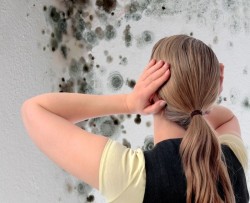 Often mold appears in our homes, which can be of several types:
Often mold appears in our homes, which can be of several types:
- white mold usually appears in flower pots as a reaction to excessive moisture or the use of certain specific fertilizers. Exposure to humans may occur as an allergy;
- green mold may appear on food: eating contaminated food runs the risk of serious illness. Green mold also rarely affects building materials, for example, brick;
- black mold - enemy number 1. This is the most common type of mold that can hit any surface: wallpaper, paint, plaster, boards, concrete etc. If you do not fight it, then it can subsequently cause insomnia, dizziness, fever, headaches, and in the worst case, asthma, bronchitis, dermatitis, pneumonia and even lung cancer;
 blue stain often appears on wooden surfaces in the house: parquet, frames, furniture, etc. They begin to acquire an unpleasant muddy-blue hue, the paint layer is destroyed, and even the paintwork does not save;
blue stain often appears on wooden surfaces in the house: parquet, frames, furniture, etc. They begin to acquire an unpleasant muddy-blue hue, the paint layer is destroyed, and even the paintwork does not save;- rot mold - one more enemy of wood. Depending on some features, a tree may acquire a gray or brown hue, become lighter, cracks appear on it, etc.
Before mold, not one of the finishing materials known to us is resistant. But besides harm repairshe also toxic to the human body, especially for children. Depending on the level of mold spread in the apartment, the symptoms may be different: first, there is an effect on the respiratory system, and then on the whole organism. Evidence of the negative effect of the fungus is the appearance of cough, runny nose, lack of air, chronic diseases that are difficult to diagnose - all this is the reason for being in a damp room infected with mold.
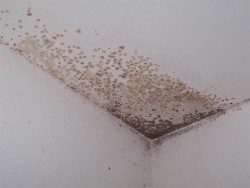 Mold can also cause nausea, vomiting, headache, and fatigue. In addition to the fact that it looks unaesthetically, it also destructively affects building materials: it penetrates the structure, quickly spreads and occupies new areas. That is why after detecting even hints of mold, it must be removed immediately.
Mold can also cause nausea, vomiting, headache, and fatigue. In addition to the fact that it looks unaesthetically, it also destructively affects building materials: it penetrates the structure, quickly spreads and occupies new areas. That is why after detecting even hints of mold, it must be removed immediately.
Causes and signs of mold
In order to get rid of mold once and for all, it is enough to clearly determine the reason for its appearance in your apartment, and eliminate it.The fact is that fungal spores are present in any room, but the basis for their development is favorable conditions, which become causes of moldy stains in different parts of your home:
 high humidity in combination with poor ventilation, which often happens in the kitchen or bathroom, in apartments on the ground floors, houses where abuse with moisture, etc .;
high humidity in combination with poor ventilation, which often happens in the kitchen or bathroom, in apartments on the ground floors, houses where abuse with moisture, etc .;- freezing walls;
- unpaved dampness;
- leakage of water pipes;
- roof leakage;
- badly heated room.
Everyone probably already encountered the phenomenon of mold and easily recognized it: this is the appearance of an unpleasant raw smell, spots of black, gray or white. To get rid of mold forever, you need to apply a set of measures, and in addition to the means described below aimed at combating the already appeared fungus, it is imperative to eliminate the cause of the appearance.
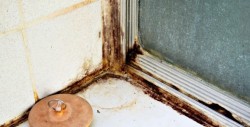 In general, all mold control work in the house comes down to the following list of activities:
In general, all mold control work in the house comes down to the following list of activities:
- clean the affected surface from mold;
- treat the surface with an anti-mildew agent;
- throw away all things severely damaged by the fungus;
- create normal indoor conditions: good ventilationNormal heating, eliminate all sources of high humidity.
There are a lot of mold remedies at the moment, each of them is applicable in certain conditions and differs in some features.
Ways to get rid of mold
You can deal with mold both by special means, which are sold in a sufficient assortment on store shelves, as well as folk methods. The second will be less harmful to the person himself, will cost less, and in terms of effectiveness they are not always inferior to their professional counterparts.
Method number 1. Antiseptic primer
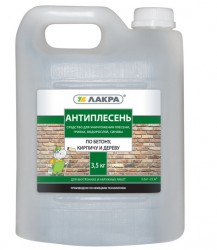 This is the most proven method that will definitely help in the fight against fungus. In construction stores, such products are presented in a wide assortment: Fongifluid Alpa, Dali, Olympus Stop mold, Biotol spray, etc. Their application to the infected surface not only helps to get rid of the fungus, but also prevent its appearance in the future.
This is the most proven method that will definitely help in the fight against fungus. In construction stores, such products are presented in a wide assortment: Fongifluid Alpa, Dali, Olympus Stop mold, Biotol spray, etc. Their application to the infected surface not only helps to get rid of the fungus, but also prevent its appearance in the future.
Working with such a solution is very simple: it is sold either in finished form, or they need to add a clearly defined amount of water, as indicated in the instructions. Next, it is only worth applying the resulting composition to the required surface, and you're done.
Important: must be applied antiseptic primer only on a well-cleaned surface, therefore, all the material affected by the fungus must be carefully removed, and if it is deeply ingrained, then it will be necessary to clean all layers up to the brick or concrete slab. Then the primer is evenly applied with a normal paint brush to a dry surface. When the protection layer dries, you can begin to finish: glue wallpaper, paint the walls, plaster, etc.
Method number 2. Bleach
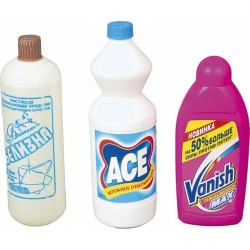 Bleach is an easier way to get rid of mold in the house, a worthy replacement for professional means. The composition of conventional bleach includes sodium hypochlorite (it is also present in many special products as an active substance), which has a detrimental effect on mold and its spores, so this is a reliable way to get rid of almost all types of mold. But you can not use bleach on all surfaces, as they can fade, deteriorate, etc. The bleach is great for glass, tile, bath, other non-porous materials, but powerless for drywall, wood, etc. The fact is that the active substance, chlorine, in this case does not penetrate into the material where the mold particles are located, but acts only on the surface. And the water that is part of such a solution is absorbed by porous materials, leading to even greater development of mold.
Bleach is an easier way to get rid of mold in the house, a worthy replacement for professional means. The composition of conventional bleach includes sodium hypochlorite (it is also present in many special products as an active substance), which has a detrimental effect on mold and its spores, so this is a reliable way to get rid of almost all types of mold. But you can not use bleach on all surfaces, as they can fade, deteriorate, etc. The bleach is great for glass, tile, bath, other non-porous materials, but powerless for drywall, wood, etc. The fact is that the active substance, chlorine, in this case does not penetrate into the material where the mold particles are located, but acts only on the surface. And the water that is part of such a solution is absorbed by porous materials, leading to even greater development of mold.
Working with bleach can hardly be called safe, as it can corrode the skin of the hands, cause poisoning by toxic fumes.Therefore, it can only be used in a well-ventilated area and in rubber protective gloves. The solution is prepared from bleach and water in a ratio of 1:10, applied with a brush and waiting for complete drying. As in the previous case, the previously damaged surface must be cleaned.
Method number 3. Vinegar
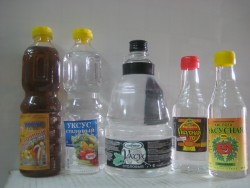 The usual vinegar that everyone has in the kitchen is a weak acid, which is poison for many types of mold. Its advantage is that it does not emit any hazardous fumes, so it is completely safe to use it.
The usual vinegar that everyone has in the kitchen is a weak acid, which is poison for many types of mold. Its advantage is that it does not emit any hazardous fumes, so it is completely safe to use it.
Vinegar is sprayed onto the prepared surface, and then it is wiped with a damp cloth, after an hour the surface is washed with water and the room is well ventilated. In particularly damaged areas, such a procedure is best done several times with a frequency of one week.
Method number 4. Hydrogen peroxide
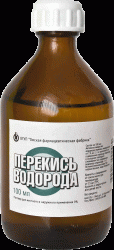 Hydrogen peroxide is another poison for most types of mold. You can buy a 3% solution of peroxide in any pharmacy, for a person its smell is not so harmful, so working with it is more or less convenient. It must be applied to the prepared surface cleaned from mold, but since peroxide also has a whitening effect, it is better not to apply it to painted surfaces, but to choose a different method.
Hydrogen peroxide is another poison for most types of mold. You can buy a 3% solution of peroxide in any pharmacy, for a person its smell is not so harmful, so working with it is more or less convenient. It must be applied to the prepared surface cleaned from mold, but since peroxide also has a whitening effect, it is better not to apply it to painted surfaces, but to choose a different method.
Method number 5. Ammonia
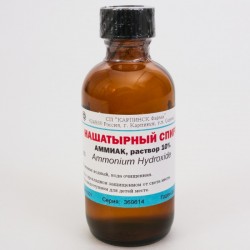 Liquid ammonia is similar in action to bleach: it copes well with mold on hard non-porous surfaces, but is not very effective on porous materials. It does its job perfectly when mold forms, for example, on tile or glass.
Liquid ammonia is similar in action to bleach: it copes well with mold on hard non-porous surfaces, but is not very effective on porous materials. It does its job perfectly when mold forms, for example, on tile or glass.
Ammonia must be mixed with water in a ratio of 1: 1 and sprayed onto the infected surface, and after an hour rinse the solution with water and ventilate the room well. It is necessary to work with ammonia very carefully, since its pungent odor can cause dizziness, headaches, etc. Be careful and do not try to use it in combination with bleach, as the reaction between them leads to the release of toxic gases.
Method number 6. Baking soda
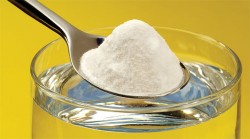 Soda is one of the easiest and safest ways to get rid of mold, and it does not harm either humans or pets. It is enough to prepare a solution of soda - dissolve a teaspoon in a glass of water - and spray the surface affected by mold with the resulting composition. You can also wipe moldy things, walls, objects with a sponge dampened in this solution. After an hour, the surface needs to be washed with water, but it is not recommended to completely wash off the soda solution from it: soda is not able to harm the material, but it perfectly protects against reappearance of the fungus.
Soda is one of the easiest and safest ways to get rid of mold, and it does not harm either humans or pets. It is enough to prepare a solution of soda - dissolve a teaspoon in a glass of water - and spray the surface affected by mold with the resulting composition. You can also wipe moldy things, walls, objects with a sponge dampened in this solution. After an hour, the surface needs to be washed with water, but it is not recommended to completely wash off the soda solution from it: soda is not able to harm the material, but it perfectly protects against reappearance of the fungus.
Method number 7. Borax
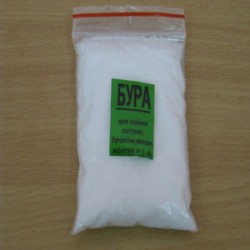 Borax is a natural material, therefore it cannot harm human health. It is often used in the disinfection of toilets and drains, acts as an effective fungicide, insecticide and herbicide, in general, is an inhibitor of mold development and a toxin for it.
Borax is a natural material, therefore it cannot harm human health. It is often used in the disinfection of toilets and drains, acts as an effective fungicide, insecticide and herbicide, in general, is an inhibitor of mold development and a toxin for it.
It is recommended that before starting mold removal work, first vacuum the surface with a fine filter so that in the process as few pores as possible fly in the air and enter the respiratory system. The working solution is prepared as follows: 1 glass of borax is diluted in 2.5 liters of water. The borax solution is applied to the surface with a stiff brush, while at the same time brushing off the fungus itself from walls, objects, floors, etc. it is advisable to walk on the surface with such a solution several times, rinsing off is unnecessary, as in the future the drill will become a reliable protector against mold.
Method number 8. Tea tree oil
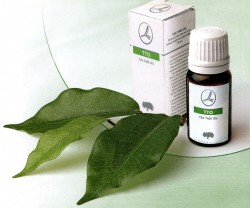 Tea tree oil is one of the most effective natural remedies that are completely harmless to humans. Although this oil is not cheap, it will require very little, it has strong antibacterial and antifungal agents.
Tea tree oil is one of the most effective natural remedies that are completely harmless to humans. Although this oil is not cheap, it will require very little, it has strong antibacterial and antifungal agents.
One glass of water will require a teaspoon of tea tree oil.This mixture is added to the spray gun and applied to the damaged surface, or used for application on a sponge, it will not need to be washed off, since this solution will reliably protect against the possible reappearance of the fungus.
Tea tree has its own specific smell, but it is harmless and will disappear after a while. By the way, the prepared solution for combating mold can be stored for as long as you like, since over time it does not lose its strength and does not deteriorate.
Method number 9. Grapefruit Seed Extract
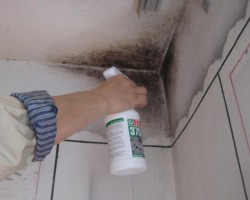 This remedy in action resembles tea tree oil, it is also expensive, but it differs in the absence of smell, disinfecting and deodorizing effect.
This remedy in action resembles tea tree oil, it is also expensive, but it differs in the absence of smell, disinfecting and deodorizing effect.
The solution is prepared very simply: one glass of water will require only 10 drops of grapefruit seed extract. Again, we use a spray gun for application, and after application we do not wash off the solution, since the longer it will contact the damaged surface, the better, and in the future this solution will protect the walls and floors from the appearance of new mold spots.
Method number 10. Manganese solution
Normal potassium permanganate also has a detrimental effect on mold. The damaged surface can be treated with a weak solution of potassium permanganate: add 1 teaspoon of potassium permanganate to 1 liter of water, and spray or wipe the damaged areas with the resulting composition. The solution can not be washed off, it will be effective for some time.
Method number 11. Lavender and Rosemary Essential Oil
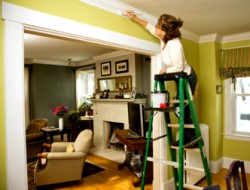 These oils contain substances that can counteract the development and vital activity of mold, so just add a few drops of aromatic oil to a glass of water and then treat the surface: there will be no unpleasant smell of chemicals, these oils are non-toxic to humans, and they kill most mold types .
These oils contain substances that can counteract the development and vital activity of mold, so just add a few drops of aromatic oil to a glass of water and then treat the surface: there will be no unpleasant smell of chemicals, these oils are non-toxic to humans, and they kill most mold types .
Method number 12. Stationery glue
Many craftsmen get rid of mold with the help of stationery glue, which divorces one to one with water. The method is effective in some cases, but does not cope with all types of mold, and if the lesion is not very large.
Method number 13. Iodine solution and camphor balls
A solution of iodine and camphor balls will help only if you just found small traces of mold, and you do not want to use more aggressive means of control. Therefore, in an infected room, you can arrange containers with a solution of iodine or spread camphor balls.
Method number 14. Lemon acid
To combat the fungus, citric acid or lemon juice, which have the same properties as vinegar, is suitable - it is a weak organic acid that negatively affects the development of the fungus. A teaspoon of citric acid is dissolved in a glass of water, and the surface is treated with the resulting solution. The method is great for tiles.
Method number 15. Hydrogen peroxide + vinegar + boric acid
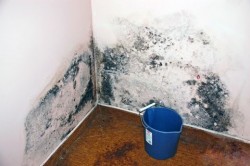 All these components are able to cope with mold at the highest level, and all together give a generally amazing effect. Water must be mixed with peroxide, vinegar and boric acid in a ratio of 4: 2: 2: 1, and then sprayed onto the surface or wiped it.
All these components are able to cope with mold at the highest level, and all together give a generally amazing effect. Water must be mixed with peroxide, vinegar and boric acid in a ratio of 4: 2: 2: 1, and then sprayed onto the surface or wiped it.
Method number 16. Get rid of for sure
Even if, in accordance with all the instructions, you have carried out the fight against the formed mold, there is still no guarantee that it will not appear again. It is important not only to remove the already appeared fungus, but also to eliminate all possible causes of its reappearance. That is why you need:
- reliably insulate an apartment or house;
- repair or replace the heating system;
- install air conditioning for air drying;
- establish a ventilation system;
- to dry clothes not in the room, but on the balcony or purchase a washing machine with a drying function;
- use the hood when cooking food;
- ventilate all rooms well;
- eliminate leakage of the roof, taps, etc .;
- geraniums and violets are a great place for propagating mold, so their presence in the apartment should be limited;
- from the point of view of the appearance of mold, regularly wipe the most risky places, spray with means from a fungus.
How to remove the smell of mold?
Often, after removing mold from the apartment and subsequent airing, the smell of rot still does not leave the room. You can fight it with products that absorb odors. So, in the place where the fungus used to be, you can pour soda, and after a few hours remove it with a vacuum cleaner: the soda absorbs smells perfectly, so after this procedure the smell will either disappear or become much weaker.
Charcoal can be used as an odor absorber: briquettes are simply placed around the room with an unpleasant odor, and after a while there will be no trace of it.
Some more mold control tips
Mold in each room has its own characteristics, therefore, approaches to combating it should be slightly different.
We remove mold from the walls
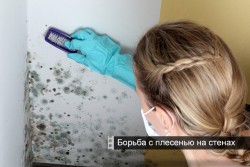 At the first sign of mold, you need to act immediately, since after 10-12 months it can reach concrete or brickwork. Therefore, you should remove the damaged finish layer, wet the wall slightly so that mold spores do not fly around the room, and remove the layer of plaster, then clean thoroughly all the plaque and sweep the room thoroughly, dry the walls and treat the mold with the chosen preparation.
At the first sign of mold, you need to act immediately, since after 10-12 months it can reach concrete or brickwork. Therefore, you should remove the damaged finish layer, wet the wall slightly so that mold spores do not fly around the room, and remove the layer of plaster, then clean thoroughly all the plaque and sweep the room thoroughly, dry the walls and treat the mold with the chosen preparation.
If the walls are painted, then the mold spreads more over the area than inside, and after removing the paintwork, you can begin the process of neutralization, moving from simpler to more powerful means.
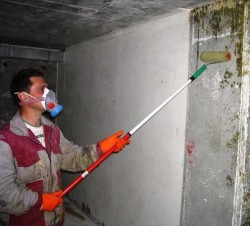 Plasterboard ceilings and walls are distinguished by their structure: they are porous, so keep in mind that mold can develop deep into the material. In this case, professional tools are suitable.
Plasterboard ceilings and walls are distinguished by their structure: they are porous, so keep in mind that mold can develop deep into the material. In this case, professional tools are suitable.
In the rooms on wallpaper the fungus spreads at lightning speed, so in most cases shoot wallpaper. This can only be avoided in the initial stages of mold development.
Ideal for combating fungus in this case is a solution of vinegar, ammonia, special formulations, lavender oil, a solution of potassium permanganate or a solution of hydrogen peroxide. But nevertheless, it is unlikely that it will be necessary to avoid dismantling at least part of the wallpaper, since all of the above tools can slightly change their color, and the likelihood that the mold has firmly settled in the apartment and is developing under the wallpaper is high.
We remove the mold from the bath
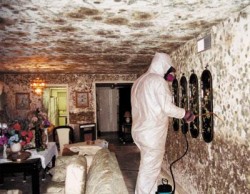 In the bathroom, the most vulnerable places are the joints between the plumbing and the wall, processed sealantas well as the seams between the tiles. A black coating appears very quickly there, which does not wash off - mold.
In the bathroom, the most vulnerable places are the joints between the plumbing and the wall, processed sealantas well as the seams between the tiles. A black coating appears very quickly there, which does not wash off - mold.
You need to act in this way according to the old scheme: remove the affected area, i.e. moldy sealant, we process with the chosen agent, and reapply the sealant. Seams between tiles clean metal scraper, and then use there grout with antiseptic properties.
If mold appeared on the ceiling, then the area should be moistened a little with water and left for 2-3 hours, then remove whitewashing and plaster, we putty all the formed bumps. Next, use a primer, which includes antifungal agents, and after drying, apply a penetrating primer. It remains only to polish the surface, and the ceiling is ready for further decoration.
You can do this by applying a solution of whiteness, soda, vinegar or tea tree to the affected area of the ceiling in the bathroom.
Finally
Often we underestimate the harm that seemingly ordinary mold can do to us. It is extremely dangerous not only for building materials, but also for health, so you need to start fighting it with a feather appearance. But at the same time, it is important to eliminate the causes of mold in order to get rid of them, otherwise all efforts may be ineffectual.

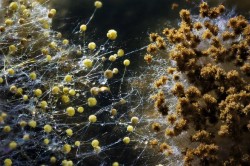
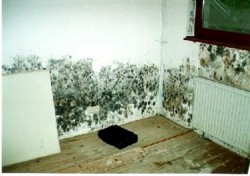
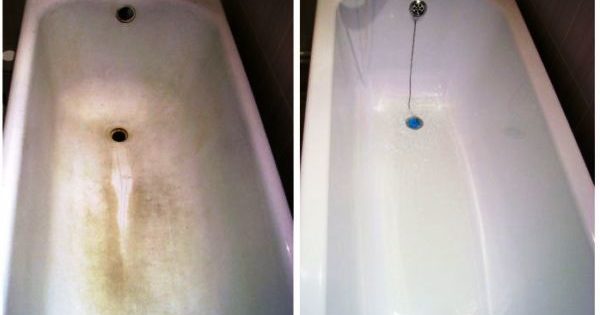
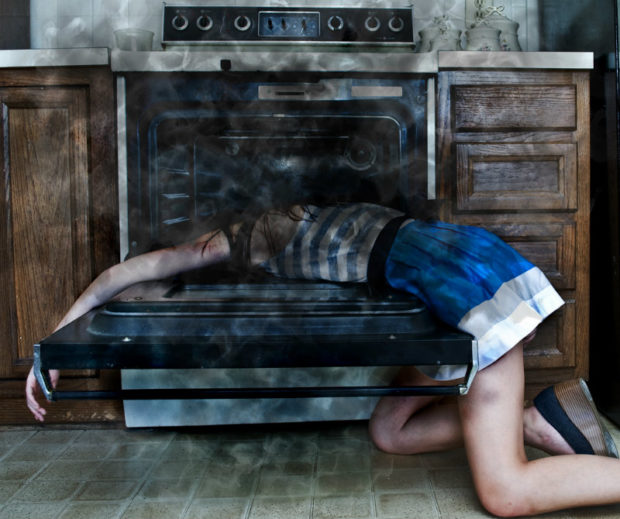
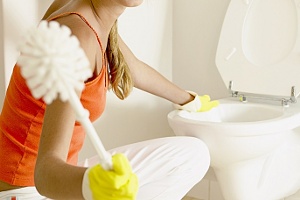
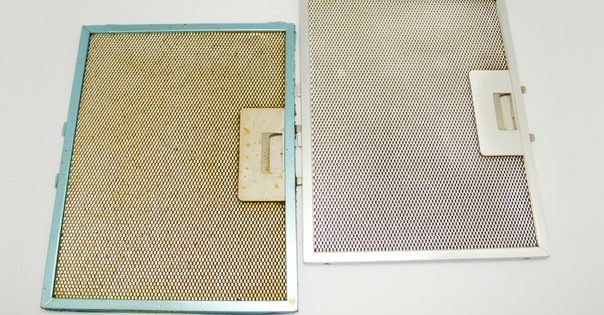
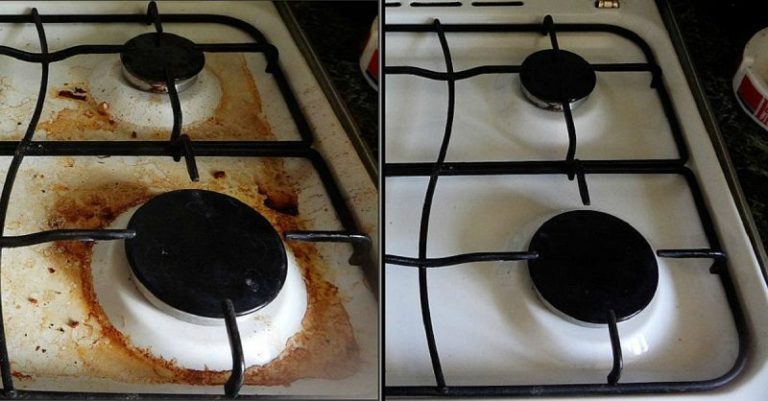
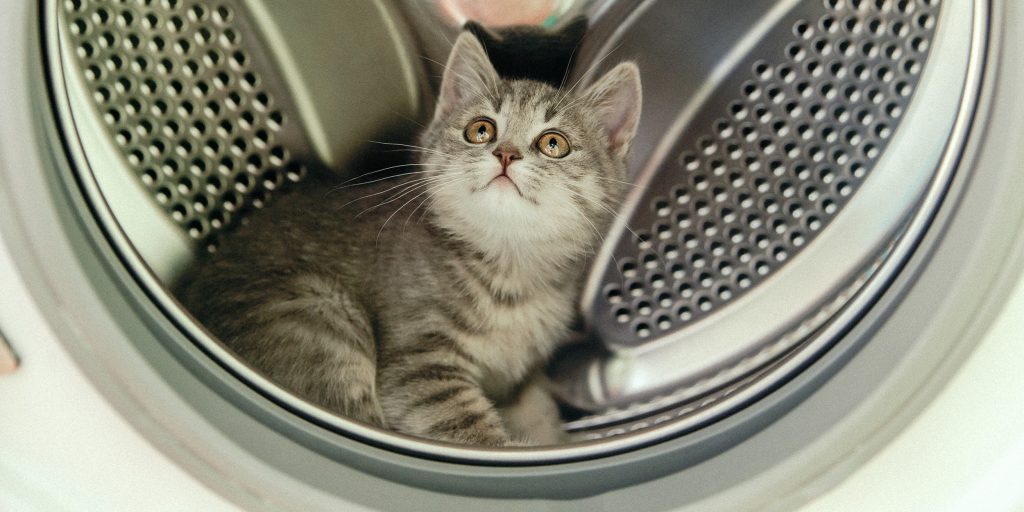
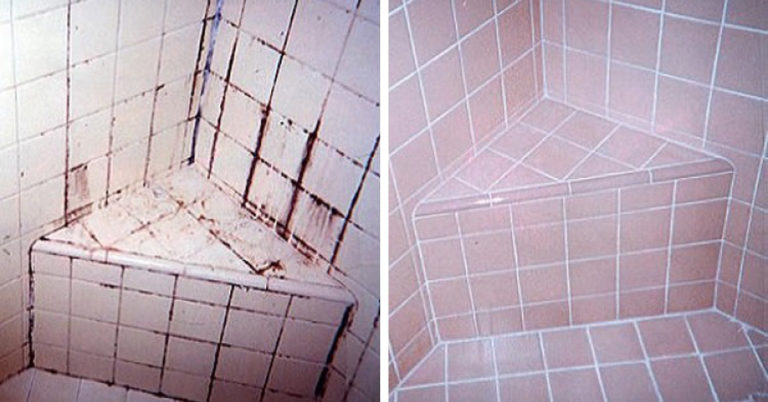
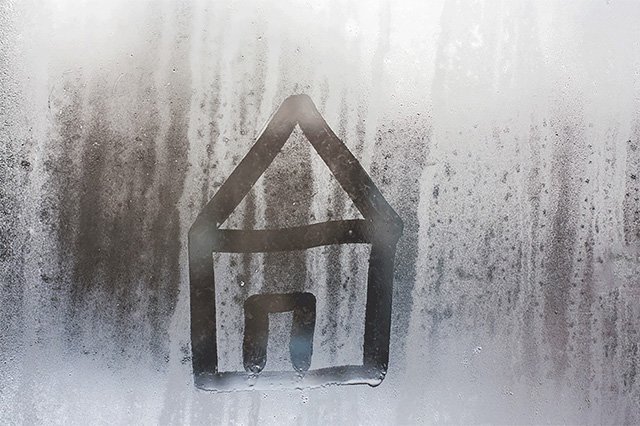


I took advantage of advice number 3: I processed one wall in the room with table vinegar. Now for the second day now I don’t know how to remove the persistent smell of vinegar. The walls of soap have already been six times and just water, and with soap. And for 5 hours she kept the window wide open. All the same, the smell remained. It looks like she got a burn on her nose and mouth. I do not advise you to mess with vinegar.
You have depicted a very sad picture. The smell can probably remain, but so that it is right up to burns of the mucous membrane.
A few tips for removing the smell of vinegar, if there was an explicit bust with its quantity:
Method number 1 Prepare a special solution for 5 liters of water 2 tbsp. washing powder and 1 tbsp. ammonia. Using a sponge, apply the solution and wipe the causal area. Use a damp sponge to remove any traces of foam. Dry the place with a hairdryer or wait until it dries by itself.
Method number 2 For this method, take a detergent for dishes.
Moisten the source of odor with water. Apply detergent with a brush or sponge, wipe the desired area. Residues should be removed with a sponge dipped in water. Dry the wet spot with a hairdryer.
admin, publish immediately a way to get rid of the smell of ammonia and detergent. please also write whether the proposed remedies for removing the smell of vinegar are a breeding ground for mold
There was green mold on the wall, on drywall. I cleaned it, Then I also chose vinegar, I was in a house in a large number. I poured a little water at the bottom of the atomizer, then 6% table vinegar. He put on glasses, sprayed. After a while, he sprayed again so that the remedy ended. No harm to health! Moreover, it seems to me weak, because sniffed after a while - through the smell of vinegar, a smell of mold in these places still distinctly made its way. Although visually it was not there for a long time. Tomorrow I will try another remedy. Thank you for making a choice !!
I used a solution of SODIUM CHLORITE (do not confuse with sodium chloride), it is the most effective imported reagent for removing mold. There is no persistent odor, it is a chemical substance that can suppress vital processes and destroy all known varieties of microorganisms, both inside the structure of a material and outside.
The main properties of the sodium chlorite solution are the fight against the activity of microorganisms and the protection of the material from the appearance of new pathogenic harmful and structure-destroying bacteria materials. I bought a canister, now I don’t know any worries, I got rid of it forever. In the bathroom, I also wipe the tiles with it.
Olga, tell me, please, where can I get sodium chlorite?
Please tell me, at my door on the side of the apartment on the doorpost this mold is in the kitchen in the lower cabinet and under the cabinet on the floor (broken), this is where I noticed it so far, I don’t know about the wall, since the kitchen is built in, but the cupboard has this muck black. The better it is to get rid and so that not every month then it is still processed well, but at least once every half a year. We live on the 1st floor
Black spots are a mold. You can try to fix it with improvised methods using a hard brush and a solution of chlorine bleach and water. Proportions 1: 3. But in your case, the mold must have hit the wall behind the headset. Therefore, eliminating it in this way once and for all is unlikely to succeed. Try more aggressive antimicrobial aerosols. Mold appears in moist, warm places.Therefore, to eliminate it long-term, it is necessary to reduce the degree of humidity. Think about purchasing an electric air dehydrator.
Do you write a weak solution of potassium permanganate? 1 hour, a spoon per 1 liter of water, it turns out almost a black liquid, which is unlikely to wash off
A teaspoon without a hill is about 5 g of potassium permanganate. When dissolved in 1000 ml (= 1000 g) of water, we obtain a concentration of 0.5%. Yes, they agree, a weaker solution (0.1%) is often used in everyday life, but this is mainly for gargling. For processing places covered with mold, you need a more concentrated solution. If you compare it, compare it with a 5% solution (used for snake bites and the treatment of fungal diseases), then 0.5% is really weak.
But this is the case, if the wall does not freeze. In frost, it is very difficult to remove condensate. Mostly heaters.
Tell me how to be, looked at the room when shopping, the wallpaper was fresh, there is no mold on them. And when they started with the keys, they began to inspect carefully, because the furniture is gone. And there is still a layer of wallpaper with mold. Now there is no way to make repairs. Somewhere in six months only. In the summer we want to put another battery, a corner room on the first floor. Will it save? What to do now?
Yes, this is your surprise from the seller. In general, it is better to get rid of mold as soon as possible. Try one of the methods listed in the article. For example, vinegar, peroxide, potassium permanganate, etc. Of course, traces will remain on the wallpaper, but if you lean the furniture, we hope that you can live somehow for 6 months.
It worked with whiteness, the mold went away for a while, but after a couple of months it appeared again. I wanted to treat it with killer whiteness again, but this smell ... I decided not to risk it and buy some antiseptic (I had septocil, I took it because it was harmless) until I returned. It will be seen further, but at least there was no nasty smell.